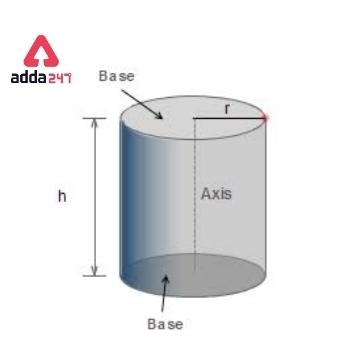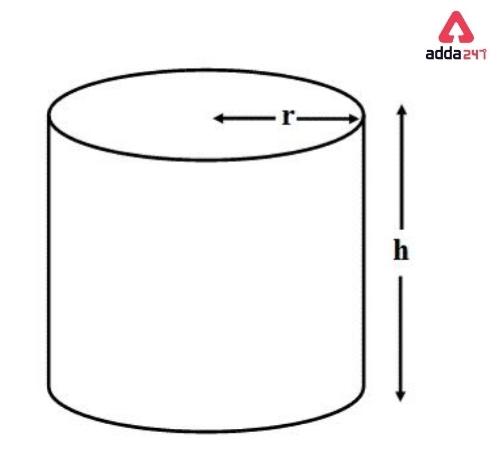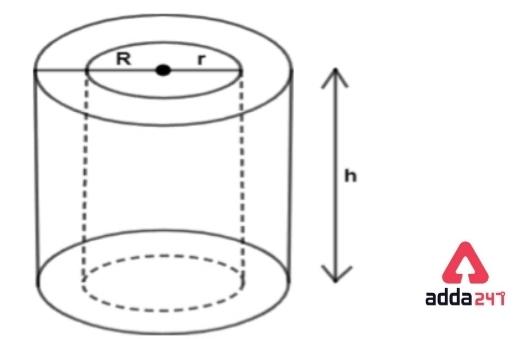Table of Contents
Volume of Cylinder
A cylinder is a three-dimensional geometric shape that consists of two parallel circular bases connected by a curved surface. The volume of a cylinder refers to the amount of space enclosed by its surfaces. It is measured in cubic units, such as cubic centimeters (cm³) or cubic meters (m³).
Volume of Cylinder Formula
The formula for calculating the volume of a cylinder is:
V = πr²h
In this formula:
- V represents the volume of the cylinder.
- π (pi) is a mathematical constant approximately equal to 3.14159. It is used to calculate the area of a circle.
- r represents the radius of the circular base of the cylinder. The radius is the distance from the center of the base to its outer edge.
- h represents the height of the cylinder. It is the distance between the two bases, or the length of the curved surface.
Cylinder Volume Formula
The Volume of cylinder defines the holding capacity of a cylinder or in other words, the quantity of materials that can carry or hold by a cylinder, known as volume of cylinder. The volume of cylinder is calculated by the formula V= πr² h. In this article, we will learn about cylinders, the Volume of a cylinder, and the total surface area of a cylinder.
To calculate the volume of a cylinder, you need to know the values of the radius and height. Simply substitute those values into the formula, square the radius, multiply by pi, and then multiply by the height. The resulting value will give you the volume of the cylinder.
It’s important to ensure that the radius and height are measured in the same units (e.g., centimeters, meters) to obtain the volume in the corresponding cubic units.
What is a cylinder volume?
In geometry, a cylinder is a three-dimensional object that consists of two parallel bases linked by a curved surface. Although a cylinder is a 3D object, it has Total surface area and volume.
Some examples of cylinders are- Pipes, batteries, Barrels, etc.
Properties of a cylinder volume Formula
• Radius of the cylinder- A cylinder consists of two parts- two parallel bases and the curved surface which linked the bases. Both the parallel bases have an equal radius (denoted by r ). A cylinder can be solid or hollow, In that case, there are two types of radius called- inner radius (r) and outer radius (R).
• Height of cylinder – The height of the cylinder suggests the distance between two parallel bases of the cylinder.

Volume of Cylinder Formula in Maths
The volume of the cylinder defines the holding capacity of a cylinder. The volume of a cylinder is nothing but the product value of the Area of the base (A) and the height of the cylinder(h)
The volume of cylinder = Area of base × Height
For any solid cylinder with a base radius ‘r’ and height of the cylinder is ‘h’

Therefore,
The volume of the cylinder is V= πr² h cube units. [π is a constant value, equals 3.14 or 22/7]
Volume of Hollow Cylinder Formula
A hollow cylinder means a cylinder that is empty from the inside. If we see a hollow cylinder from the top, it looks like an annular ring. The hollow cylinder has two types of radius called- inner radius (r) and outer radius (R).as it is bounded by two concentric circles.
For any hollow Cylinder with height ‘h’, external Radius ‘R’ and internal Radius ‘r’. so. Thickness = (R-r) .

Therefore,
The volume of the hollow cylinder is V= π(R²-r²)h cubic units. [π is a constant value, equals 3.14 or 22/7]
Formula of Volume of Cylinder Unit
The formula for the volume of the cylinder is V= πr² h cube units.
So, generally, we measure the volume of cylinders in cubic units like cubic centimeters (cm³), cubic meters (m³), cubic feet (ft³), and so on.
Volume of a Cylinder in liters
We use cylinder-shaped objects or barrels to carry mostly liquids .so, it is very necessary to find the volume of the cylinder in liters. We calculate the volume of the cylinder by cubic cm of cm³. we must convert cubic cm or cm³ into liters or vice-versa by applying the following conversion formula-
1 Litre = 1000 cubic cm or cm³
For example, a cylinder can hold 15 liters of petrol. Find the volume of the cylinder in cm³?
We know that 1 Litre = 1000 cubic cm or cm³
Now, 15 litres = 15000 cubic cm or cm³
Hence the volume of the cylinder is 15000 cubic cm or cm³.
Surface area of Cylinder Formula
The formula used for determining the surface area Of a solid Cylinder is,
A = Area of two bases+ Curved surface area
A = 2πr² + 2πrh square units.
A= 2 πr (h + r) square units.
The formula for the surface area Of a hollow Cylinder is,
A= (Area of both bases + curved surface area)
A= 2 π(R² + r²) + 2 πh( R + r) square units.
Volume of cylinder Formula Questions with answers
Example 1: The height of a cylinder is10 cm and the radius of one circular base is 7 cm. Find its volume.
a) 1540 cm³ b) 1600 cm³ c) 490 cm ³ d) None of these .
Answer- The Formula for the volume of a cylinder is, V = πr² h cubic cm
In the given problem, height is 10cm and radius is 7 cm
Volume = π (7)² × 10 cm³
Or, V = 22/7 × 49 × 10 cm³
Or, V = 1540 cm³
Hence, Option ( a ) is correct.
Example 2: The volume of a cylinder is 440 cm³ and the height is 35 cm. Find the radius of the cylinder of a base.
a) 3 cm b) 2 cm c) 4 cm d) None of these
Answer – Let’s assume the radius of the cylinder is – r cm.
In the given cylinder Volume is 440 cm³ and the height is 35 cm.
The Formula for the volume of a cylinder is, V = πr² h cubic cm.
or, 440 = (22/7) x r² x 35
or, r² = (440 x 7)/(22 x 35) = 3080/770 = 4
or, r = 4 cm
Option ( c) is correct.
Example 3: Total surface area of a cylinder is 660 cm² calculate the height of the cylinder of radius 5 cm.
a) 10 cm b) 16 cm c) 15 cm d) None of these
Answer- Let’s suppose the height of the cylinder is -h cm.
The formula used for determining the total surface area of a cylinder is,
A= 2 πr (h + r) square units.
or, 660= 2 x 22/7 x (5 + h)
or, 660×7 = 220 x (5 + h)
or, (5+h) = 21
or h = 16 cm
So, option (b) is correct.
Example 4: A pipe is 21 cm long. The inside and outside radiuses are 6 cm and 4 cm respectively. What is the volume of the water required to fill the pipe completely?
a) 1300 cm³ b) 3234 cm³ c) 1320 cm³ d) None of the above
Answer – In the given Information,
Inner radius – r = 4 cm
Outer radius – R = 6 cm
Height – h = 21 cm
The volume of the hollow cylinder is, V= π(R²-r²)h cubic units
or. V= π × (6² – 4² ) ×21
or.V= 22/7 ×(36- 16 ) ×21
or.V= (22× 20 ×21) /7
or.V = 1320 cm³
So, option ( C ) is correct.
Volume of Cylinder Formula- Exercise Questions
- The height of a cylinder is12 cm and the radius of one circular base is 3 cm. Calculate the volume of the cylinder.
- The volume of the cylinder is 12000 cm³. How many liters of water the cylinder can hold?
- The total surface area of a cylinder is 165 m². The height of the cylinder is 15 m. Find out the radius of the base of the cylinder.
- The height of a cylinder is 6 cm and the volume of the cylinder is 180 cm³. Calculate the area of the base of the cylinder?
What is the Volume of Cylinder in Hindi- सिलेंडर का आयतन
सिलेंडर का आयतन एक सिलेंडर की धारण क्षमता को परिभाषित करता है या दूसरे शब्दों में, सामग्री की मात्रा जो एक सिलेंडर द्वारा ले जा सकती है या धारण कर सकती है, जिसे सिलेंडर की मात्रा के रूप में जाना जाता है। बेलन का आयतन सूत्र V= r² h द्वारा परिकलित किया जाता है। इस लेख में हम बेलन, बेलन का आयतन और बेलन के कुल पृष्ठीय क्षेत्रफल के बारे में जानेंगे।
सिलेंडर का आयतन: सिलेंडर क्या है?
ज्यामिति में, एक सिलेंडर एक त्रि-आयामी वस्तु है जिसमें एक घुमावदार सतह से जुड़े दो समानांतर आधार होते हैं। . हालांकि एक सिलेंडर एक 3D वस्तु है, इसमें कुल सतह क्षेत्र और आयतन होता है।
सिलेंडर के कुछ उदाहरण हैं- पाइप, बैटरी, बैरल आदि।
सिलेंडर का आयतन: एक सिलेंडर के गुण
• बेलन की त्रिज्या- एक बेलन में दो भाग होते हैं- दो समानांतर आधार और वक्र सतह जो आधारों को जोड़ती है। दोनों समान्तर आधारों की त्रिज्या समान होती है (r द्वारा निरूपित)। एक बेलन ठोस या खोखला हो सकता है, उस स्थिति में दो प्रकार की त्रिज्याएँ होती हैं जिन्हें आंतरिक त्रिज्या (r) और बाहरी त्रिज्या (R) कहा जाता है।
• बेलन की ऊँचाई – बेलन की ऊँचाई बेलन के दो समानांतर आधारों के बीच की दूरी को दर्शाती है।


 TN CM Talent Search Exam Results 2024 OU...
TN CM Talent Search Exam Results 2024 OU...
 UUCMS Login Result 2024 Out, Check Karna...
UUCMS Login Result 2024 Out, Check Karna...
 MCBU Result 2024 Out, Get Maharaja Chhat...
MCBU Result 2024 Out, Get Maharaja Chhat...





























